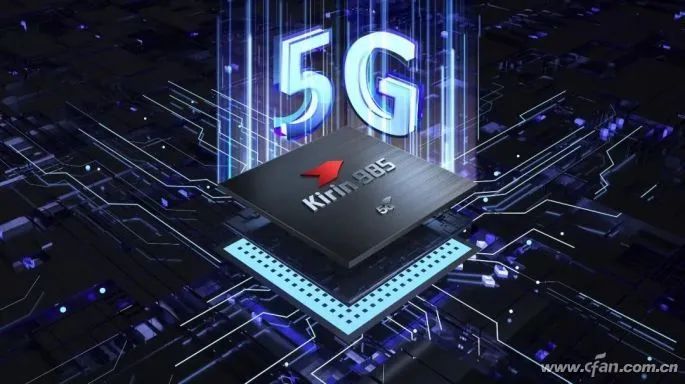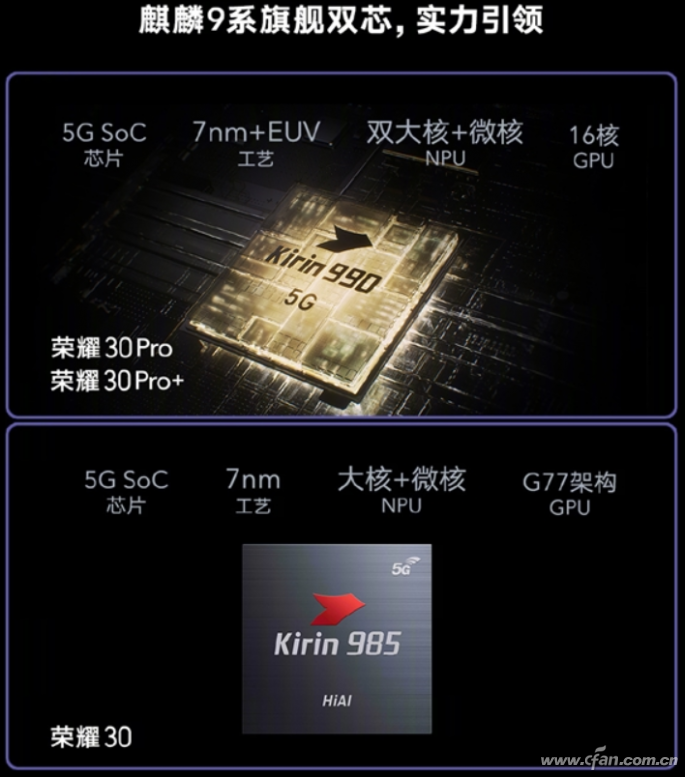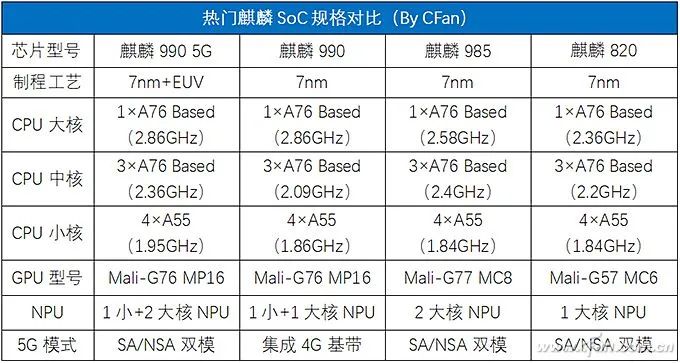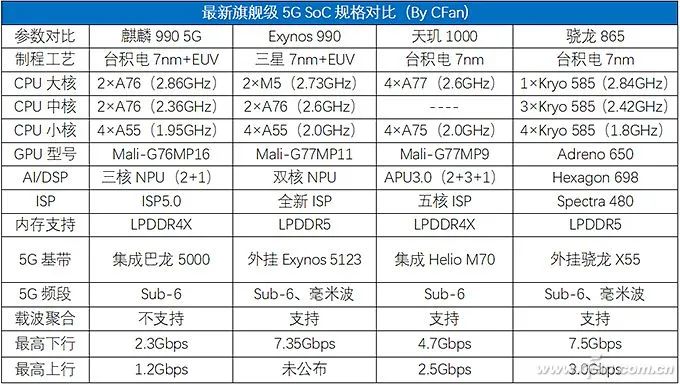
Click the above Computer Enthusiasts to follow us
With the launch of the Honor 30 featuring the Kirin 985, Huawei HiSilicon’s 5G SoC has finally gathered the three musketeers – Kirin 990 5G, Kirin 985, and Kirin 820. So, as a new product, what level of SoC is the Kirin 985? Comparing with Its Own FamilyFirst, let’s compare the Kirin 985 with its own family. The Kirin 985 does not use TSMC’s second-generation 7nm EUV process, but rather the first-generation 7nm process, the same as the Kirin 990 (4G version) and Kirin 820.
Comparing with Its Own FamilyFirst, let’s compare the Kirin 985 with its own family. The Kirin 985 does not use TSMC’s second-generation 7nm EUV process, but rather the first-generation 7nm process, the same as the Kirin 990 (4G version) and Kirin 820. In terms of CPU, the Kirin 990 series, Kirin 985, and Kirin 820 all adopt a “1+3+4” tri-cluster architecture. The large and medium cores of the Kirin 985 are still based on a modified ARM Cortex-A76, which Huawei refers to as Based, similar to Qualcomm’s Kryo, which is also modified from the native Cortex-A architecture. However, the Kirin 985’s clock speed is set between the Kirin 990 4G and Kirin 820, so its CPU performance is better than the Kirin 820 but inferior to the Kirin 990 series.On the GPU side, the Kirin 985 integrates ARM’s latest Mali-G77 GPU, paired with 8 computing cores. The Mali-G77 was released around the same time as the Cortex-A77 and is an upgrade from the Mali-G76. However, the 8-core Mali-G77 may still not match the 16-core Mali-G76 in 3D performance, but it is undoubtedly more power-efficient. In today’s relatively overpowered performance landscape, the Kirin 985 should exhibit lower heat and power consumption when playing common online games like “Honor of Kings” and “Peacekeeper Elite”.
In terms of CPU, the Kirin 990 series, Kirin 985, and Kirin 820 all adopt a “1+3+4” tri-cluster architecture. The large and medium cores of the Kirin 985 are still based on a modified ARM Cortex-A76, which Huawei refers to as Based, similar to Qualcomm’s Kryo, which is also modified from the native Cortex-A architecture. However, the Kirin 985’s clock speed is set between the Kirin 990 4G and Kirin 820, so its CPU performance is better than the Kirin 820 but inferior to the Kirin 990 series.On the GPU side, the Kirin 985 integrates ARM’s latest Mali-G77 GPU, paired with 8 computing cores. The Mali-G77 was released around the same time as the Cortex-A77 and is an upgrade from the Mali-G76. However, the 8-core Mali-G77 may still not match the 16-core Mali-G76 in 3D performance, but it is undoubtedly more power-efficient. In today’s relatively overpowered performance landscape, the Kirin 985 should exhibit lower heat and power consumption when playing common online games like “Honor of Kings” and “Peacekeeper Elite”. In other aspects, the Kirin 985 integrates the same dual large-core NPU AI unit and ISP 5.0 image unit as the Kirin 990 series, with a 5G modem sourced from the Balong 5000. In terms of AI performance ranking, it is Kirin 990 5G > Kirin 985 > Kirin 990 > Kirin 820, while in multimedia and network experience, these SoCs perform similarly.Compared to Other CompetitorsIn the mid-range 5G SoC market, the performance of the Kirin 820 is second only to the Dimensity 1000L, leading the Snapdragon 765G, Exynos 980, Dimensity 800, and Tiger T7520 competitors. Considering the niche nature of the Dimensity 1000L, when 5G smartphones equipped with the Kirin 820 (such as the Honor 10X series) are priced around 1XXX yuan, they will be unbeatable.
In other aspects, the Kirin 985 integrates the same dual large-core NPU AI unit and ISP 5.0 image unit as the Kirin 990 series, with a 5G modem sourced from the Balong 5000. In terms of AI performance ranking, it is Kirin 990 5G > Kirin 985 > Kirin 990 > Kirin 820, while in multimedia and network experience, these SoCs perform similarly.Compared to Other CompetitorsIn the mid-range 5G SoC market, the performance of the Kirin 820 is second only to the Dimensity 1000L, leading the Snapdragon 765G, Exynos 980, Dimensity 800, and Tiger T7520 competitors. Considering the niche nature of the Dimensity 1000L, when 5G smartphones equipped with the Kirin 820 (such as the Honor 10X series) are priced around 1XXX yuan, they will be unbeatable. In the high-end 5G SoC market, the overall performance of the Kirin 985 is comparable to that of the Kirin 990 + external Balong 5000 solution (such as Honor V30, Mate 30 series) and Dimensity 1000, slightly inferior to the Kirin 990 5G (which is necessary, otherwise the Kirin 985 might be called Kirin 995), and the gap to the Snapdragon 865 is even larger.
In the high-end 5G SoC market, the overall performance of the Kirin 985 is comparable to that of the Kirin 990 + external Balong 5000 solution (such as Honor V30, Mate 30 series) and Dimensity 1000, slightly inferior to the Kirin 990 5G (which is necessary, otherwise the Kirin 985 might be called Kirin 995), and the gap to the Snapdragon 865 is even larger. In summary, the emergence of the Kirin 985 signals the retirement of the Kirin 990 4G version. It will join the Kirin 990 5G and Kirin 820 to form Huawei/ Honor’s three defensive lines in the 5G battlefield, with 7nm process + native integrated 5G modem and better AI performance being its major weapons.In the near future (September and October), Huawei will also release the next generation 5G flagship – Kirin 1020, which is said to debut with TSMC’s 5nm process and ARM’s latest Cortex-A78 CPU + Mali-G78 GPU, achieving a comprehensive performance lead over the Snapdragon 865. For Qualcomm to suppress the Kirin 1020, they will have to wait until the Snapdragon 875 is launched early next year.
In summary, the emergence of the Kirin 985 signals the retirement of the Kirin 990 4G version. It will join the Kirin 990 5G and Kirin 820 to form Huawei/ Honor’s three defensive lines in the 5G battlefield, with 7nm process + native integrated 5G modem and better AI performance being its major weapons.In the near future (September and October), Huawei will also release the next generation 5G flagship – Kirin 1020, which is said to debut with TSMC’s 5nm process and ARM’s latest Cortex-A78 CPU + Mali-G78 GPU, achieving a comprehensive performance lead over the Snapdragon 865. For Qualcomm to suppress the Kirin 1020, they will have to wait until the Snapdragon 875 is launched early next year.

Click “Read Original” for more exciting content